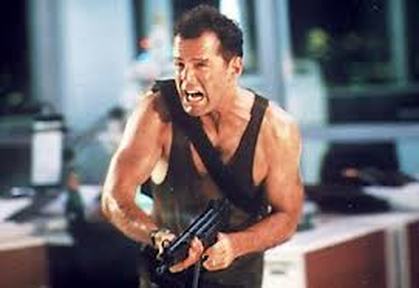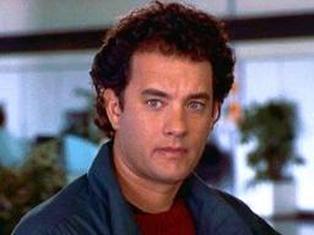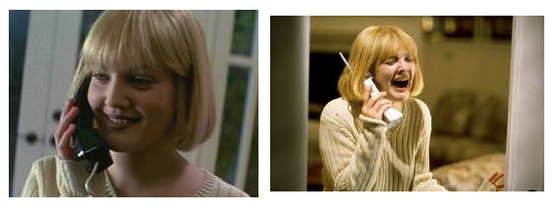1. John McClane, Die Hard
INT. 747 – PASSENGERS
The usual moment just after landing when you let out that sigh of relief that you’ve made it in one piece. As the plane TAXIS to its gate, they stir, gather personal belongings.
ON JOHN MCCLANE
mid-thirties, good looking, athletic and tired from his trip. He sits by the window. His relief on landing is subtle, but we NOTICE.
Then we meet McClane. By virtue of the fact that he is not one of them, he is not normal. He is special. He is the hero of this story.
Now that McClane’s uniqueness has been identified, the audience innately trusts in his expertise for the rest of the movie, and the writer’s job is done.
THE BOTTOM LINE
This is a perfect example of what we call “Separation Elevation.” By separating McClane from the masses, he’s been elevated to a very important level in the minds of the audience.
2. Sam Baldwin, Sleepless in Seattle
Notice the exact language Nora Eprhon uses in describing Sam. His neck is pinched into a dress shirt and tie. So we get the impression this isn’t his usual attire.
Then Ephron begins to use Sam's character introduction to also address one of the major themes of the movie: distance.
Sam's expression is described as "vacant, faraway." That's the first indication of distance in a film wherein distance serves as one of the main antagonists. Throughout the screepnlay, distance is used as a very literal representation of what truly stands between the two main characters.
Along the same lines, Ephron closes this introduction by bringing in an image of the Chicago skyline. Here she juxtaposes Sam with his city. In a movie where cities play such a prominent role, this can’t be by accident.
THE BOTTOM LINE
Ephron uses Sam’s character introduction to underscore the thematic purpose of Sleepless In Seattle. She clearly took her time with this introduction, involving both character and theme from the very beginning.
3. Will Hunting, Good Will Hunting
Will Hunting, 20, handsome and confident, a soft-spoken leader.
And it works.
Here’s why the books and gurus are wrong: Your only job in a character introduction is to engage the audience without confusing them.
By identifying Will Hunting as ‘a soft-spoken leader’ the writer immediately endears me to the character. Everyone likes a soft-spoken leader, and that’s the kind of person I absolutely want to watch a movie about.
THE BOTTOM LINE
You should never get hung up on arbitrary screenwriting rules and regulations. Write the words your story dictates. Keep people entertained. Those are the only rules that really matter, even when it comes to character introductions.
4. Casey Becker, Scream
ON A RINGING TELEPHONE
A hand reaches for it, bringing the receiver up to the face of CASEY BECKER, a young girl, no more than sixteen. A friendly face with innocent eyes.
The biggest contributing factor to that is the use of foreshadowing. How perfect is it that Casey Becker is described as having ‘innocent’ eyes?
The guy on the end of the phone is about to completely change that, and that’s kind of a beautiful thing.
One of the themes in this movie is innocence (or the loss of innocence), and we’ve got all that referenced in these two simple lines.
THE BOTTOM LINE
Character introductions are some of the best places for you to set up the journey your characters are about to (or need to) go on.
If your character is naïve, let the audience know. The adjectives you choose will be inherently rich with foreshadowing, and that’s the kind of depth that resonates well with readers.
It's a great way to establish your most important character arcs, and to let the reader know where each character stands before the story takes off running.
5. Ben Stone, Knocked Up
BEN STONE, 23, cute in a chunky Jewish guy sort of way, boxes one of his roommates, MARTIN.
There are two really cool things about this introduction.
First, it communicates tone. This is a light, fun introduction, and it’s part of a light, fun movie. Apatow stays true to this with everything he writes: There are jokes everywhere, not just in the dialogue, and everything is written in his unique, comedic voice.
Second, this introduction uses a technique we like to call “Action Definition.” Seth Rogen’s character (and his character flaw) are immediately defined by what he’s doing in this introduction.
It’s a chunky jewish guy BOXING his roommate. Clearly, he needs to grow up. That’s what the movie will be about, so that’s what the character introduction is about.
This is another example of how deeply great scripts interweave theme with character from the very beginning. If you’re not doing this, you should be.
THE BOTTOM LINE
Actions speak louder than words. Try to use the “Action Definition” technique to introduce one of your main characters, and get their entire essence across with Apatowian ease.
6. Bertie, The King's Speech
CLOSE ON - BERTIE - the Duke of York, second son of the King; his handsome, sensitive, features look terrified. (from the official Oscar nominated draft)
White ostrich feathers, topping a tri-corner hat, are fluffed and placed upon brilliantined hair.
PAN DOWN to the handsome features of Albert, Duke of York, known to his family as BERTIE. He’s in his late thirties, the second son of King George V, the reigning King of England. He conveys a sensitivity which appears in conflict with the manner in which he’s been bedecked. (from a draft dated two years earlier, Sept. 2008)
What techniques did we discuss in this article are being used here?
What makes the official introduction better than the one used in an earlier draft? Or do you think it's worse?
Comment below.
If you enjoyed this article, don't forget to sign up for "The Catalyst," our weekly VIP Newsletter, below.




